Behind the Numbers: 5 Trail Bikes Compared
Behind the Numbers is made possible by Creaform Portable 3D Measurement Technologies.
Wrapping up our look at five modern trail bikes, we now put them all on the same graph to see how they look compared to each other.
If you’d like to know more about the Behind the Numbers series, aren’t familiar with the terms being used, or want to know why the hell we’re doing this, then head back to out our introduction article for that.
We’re also trying to take certain terms and set about explaining them, how they might be analysed and add some food for thought by re-inserting the violently chaotic real world in which we ride back into the analysis. Recently we touched on anti-squat, but look out for more of the Enginerding articles in the future.
The trail category boundaries are a little hazy and each brand's interpretation of a trail bike takes in their own unique experiences, environments and views on the world of riding. This leads to quite some differences in travel, geometry and intent packed between the wheels, which can make it sometimes a bit of minefield when you're looking to buy a bike. But does make it interesting to look at the category as a whole.
As with our individual analyses, we take a look at where the instant center, or IC, lies, how it might move through the travel, how the bike reacts to acceleration, or anti-squat, how the bike reacts to deceleration, or anti-rise, the infamous pedal kickback and finally the axle path the rear wheel takes.
All the bikes we analysed were ridden by one or more members of the Pinkbike team and we linked each ride article into the analyses to look at how the riding feedback could be explained with the suspension characteristics.
The Bikes
For the bikes, we tried to take a varying slice of the trail category pie and incorporated different suspension systems, travel and wheel sizes. Although the vast majority were 29", the Yeti SB140 is the flag bearer for 27.5" wheels.
Price points for the bikes varied too, from direct to consumer businesses to incredibly boutique, hand-crafted in Europe ones, somewhat showing that your suspension performance quality doesn't have to be linked directly to the price of the bike.
Since we analysed the Commencal Meta TR back in May there has been a new model introduced. Mike Kazimer has one in for testing, and so far seems to be enjoying it from his first ride impressions, with the little bike now having a touch more travel and aggressive intentions in the geometry and spec of the bike, but still using the same overall suspension layout as the previous model.
While we could generalise the bikes to each represent one of the fundamental suspension systems out there, hopefully you've seen that each system can be manipulated to the nth degree and, in the case of the Ibis Ripmo and Unno Dash, produce drastically different curves despite sharing the same four-bar, short link, co-rotating system.
None of the trail bikes we looked at had any adjustability in them, which reduces the number of curves on our graphs, but is also an interesting point when comparing them to the enduro bikes we looked at a while ago. Perhaps the trail bike category is aimed more at just grabbing your bike and going and less at tinkering and fiddling with your bike. Or maybe it's just a reflection of the brands we looked at, with many of the other bikes in their lines also not having any adjustability.
Scanning
For the entire series of trail bikes we have been using 3D scanning to capture the bike data, and an incredibly huge thank you goes out to Simon Côté and Xavier Chapon and their teams of 3D scanning experts and bike enthusiasts in both Quebec, Canada and Grenoble, France for all their help and expertise in the series.
And a thank you is extended to Bastien and Thibaut from The Factory bike shop in Fribourg, Switzerland, VLO Saint-Basile in Quebec, and Sam St-Pierre for letting us commandeer their most prized bikes for scanning.
In each of the articles we tried to show and explain one of the steps in how we went from a physical bike to a computer based kinematic ready for analysis. As simple as the process is, thanks to the easy to use hardware and software, there are still countless steps involved and expertise needed to perform them consistently well.
We chose to take the 3D scanning route to ensure that we were getting as accurate data as possible. The Behind the Numbers series remains completely independent, with us collecting the data ourselves, and so cuts past any marketing and goes straight to the suspension geeking. While some of the bikes could be measured by hand, with their longer links yielding a bigger allowable tolerance on the measurements, lots of the bikes we chose were short link bikes and have a fine tolerance on the pivot points before the curves would change from what was happening in the real world.
3D scanning also opened up the door to reviewing the components on the bike and the stack up of tolerances from the contact patch to the rider. Tires, forks, and shocks all have tolerances that can change the bike from what is shown on paper, along with all the other smaller parts that make up the complete bike.
Leverage Ratio
Leverage ratio is the ratio between how much the rear wheel moves versus how much the shock moves. If we move the shock 1 millimeter, how many millimeters is that going to move the rear wheel? For example, a ratio of 3:1, or simply called 3, would see the rear wheel moving 3mm for 1mm of shock movement.
The inverse of the leverage ratio is called the motion ratio and so keeps the rear wheel movement fixed, the 1 part of the ratio, and looks at how much the shock moves.
When we talk about leverage ratios, we use the terms progressive, linear and regressive. These are less a systematic description of just a curve on a graph and more a description of how the bike is going to feel when you ride it. Once a shock is bolted in all bikes will exhibit an increasing wheel force as you go through the travel, so it's not a description of the wheel rate curve.
When looking at the leverage ratio graphs, a progressive leverage ratio curve is one that starts high and gradually reduces in leverage ratio, finishing at a lower leverage ratio. A linear leverage ratio is one that has little to no change from start to finish and looks more horizontal. A regressive leverage ratio is the opposite of a progressive one and starts at a low leverage ratio and gradually increases. A leverage ratio curve can be solely one of these, or a combination of two or more.
And we're focussing on the actual leverage ratio curve for our analysis rather than substituting in a generic shock and looking at the wheel rate. For bike development the wheel rate is definitely considered, but it's calculated with the shocks intended to be used on the bike. While we could add in a generic shock to create the wheel rate and normalise all the curves based on the same sag to make a comparison, it doesn't take into account the differences in setup that each bike might need in the real world. Not all bikes need the same sag to work at their best, and manufacturers even quote different recommended sag starting points. So, to then compare all the bikes based on the same shock spring and sag could potentially result in an inaccurate comparison being taken away.
As a general, and good trend, all the bikes have a mostly progressive leverage ratio.
Interestingly, all bikes we looked at come with air shocks, albeit different manufacturers and models, and so would need to consider this in the development phase. Often a bike is claimed to be air or coil shock compatible, and while there is truth to this the differences in the air spring characteristics from brand to brand or model to model and the hydraulic damping characteristics play a much bigger role in how a bike will work, rather than just simply looking at either air or coil.
The Norco Sight has the overall highest leverage ratios, coming from its use of a 52.5mm stroke shock. This, combined with the 18.5% progression, made it take a little longer to find the right setup with air pressure and volume spacers, and even then, it was described as feeling more planted than poppy due to the overall high ratios allowing the shock to begin moving from the smallest of inputs. That said, its leverage ratio curve's nature lead it be predictable when riding even if it found the end of travel every now and again.
The Commencal Meta TR had less progression than the Norco but with much lower leverage ratios throughout travel and appeared to sit in a nice window of balance between spring forces and damping forces with both Mikes finding it an easy bike to setup and feel comfy on at the Field Trip in Arizona.
The Unno Dash had the lowest leverage ratios of all the bikes and also included a linear to regressive hump in the curve towards the end of travel. Unno said this was to counteract the ramp up in the air shock at the end of travel and allow them options in tuning with volume spacers to go from minimal to lots of end stroke ramp. Without knowing which shocks they were designing around it's hard to say if this end stroke hump would be detrimental with other manufacturer's shocks and configurations. But the bike was reported give the rider ample feedback, likely due to these low leverage ratios and heavily damped shock.
The Ibis Ripmo V2 follows a recognisable progressive to linear curve shape, but had this change occurring much earlier in the travel. This was potentially in conjunction with the bike's anti-squat curve to allow the bike to remain supple while the suspension mechanically gave some support in pedalling. Sometimes adjusting the leverage ratio to have a specific massaged shape or intention can result in a deficit in the bike's performance in anything other than where the specific shape was intended to work. But in the case of the Ripmo V2, it was said to work well for both Mike and RC when they rode it.
And finally, the Yeti SB140 had 15.1% progression with the straightest possible line up until half travel where there was a characteristic flick in the curve. Something that is often seen in short link bikes, despite one of the Yeti's links actually being infinitely long. The Yeti was pretty low leveraged and relied mostly on this and its end stroke ramp to provide support and then assistance in bottom out situations, with Sarah Moore even riding the little bike in the Whistler Bike Park without an issue.
Anti-Squat
Anti-squat is describing how the bike is going to react to acceleration and the load transfer that comes with it. We've taken a really close look at anti-squat in our Enginerding article, which goes into the details of how we analyse it, what assumptions we need to make and what happens when we come back to real life with our anti-squat percentages and curves.
Anti-squat requires a chain in the mix for the analysis, and given we have multiple gears, that anti-squat figure changes depending what gear you are in. For our analysis we've chosen a light climbing gear, 50-tooth, a mid-pack gear, 24-tooth and the bottom of the cassette with the 10-tooth to show the full range of anti-squat.
For the anti-squat we've split into those three gears, so as not to give you a headache. But we did generate the graph with all gears in one place if you're interested.
We also looked at what chainrings the bikes come specced with, many of them now being a 32T with only the Yeti having a 30T. While a chainring is an easy change, this should better represent how the bikes come when you buy them complete.
Generally, there is no rule for anti-squat and which gear you're in. Some bikes have increasing anti-squat values for harder gears and some have decreasing. With the anti-squat calculation using a few different moving lines and intersection points, it all depends on how the instant center of anti-squat migrates as you change gear.
The Norco Sight had its anti-squat starting at the same point for all gears, with the 50T having the least drop off as it went through its travel. Around sag it had relatively high percentages in all gears which went some way to making it supportive when climbing, along with the comfortable and steep seat angle. That seat angle placing less load on the rear contact patch when the bike is pointed uphill and allowing less noticeable effect from the forces attempting to squat the suspension.
The Commencal Meta TR had higher percentages of anti-squat all the way through travel and in the different gears, while still having the same gentle curves as the Norco and its four-bar layout. Both Mikes had good things to say about the Meta TR with its supportive climbing feel from the anti-squat and lower leverage ratio and good seating position, even reporting that they found little need for the climb switch on the shock.
With the Unno Dash we started to see the larger variance in curves that sometimes comes from the short link bikes, with its biggest variance coming in the 10T gear. But in the climbing gears there was enough mechanical support from the anti-squat and shock support from the low leverage ratios to make Mike comment on its efficiency when climbing, despite still having some of the load transfer combatted. The Unno came specced with either SRAM Eagle and a 32T chain ring or Shimano XTR and a 34T chain ring. With the Shimano having a larger chain ring and slightly larger 51T climbing cog, the bike did then have a little less anti-squat compared to the smaller chain ring equipped SRAM bike, in the region of 3% - 18% depending on the gear.
The Ibis Ripmo V2 had a bit of variance in the curves too from its short link layout, but with less variance than the Unno and maintaining a high level of anti-squat throughout most of the travel in the climbing gears. Something that went towards making the bike climb so well in conjunction with the leverage ratio curve shape. Again, down in the hardest gears the variance in anti-squat and even the curve shape is the most extreme, but in these gears the acceleration of the bike is usually at a smaller magnitude than in the easier gears and with slower bike speeds.
The Yeti SB140 also saw a high and fairly constant level of anti-squat throughout the travel range and in all gears although with a bigger drop off at the end of travel. But in the gears most use for climbing the bike had a really firm pedalling feel, with these high percentages not only combatting the load transfer but also other forces acting to compress the suspension while pedalling.
Pedal Kickback
Pedal kickback is looking at the resulting amount of crank rotation from a fixed length of chain as you go from zero to full travel. The distance between your bottom bracket and rear axle will usually change, but if the chain is a fixed length then something needs to give.
Also consider that this chain extension can be a rotation at the rear wheel or simply a rotation of the cassette that will never be felt due to you travelling faster than the resulting tug on the cassette. But when you're travelling under that critical speed or you've got the cassette engaged, like when you're climbing or locking the rear wheel when braking, it can be something to consider.
Pedal kickback also depends on the gear you're in. A simple rule for all bikes is that as you increase the size of your cassette cog you will have more pedal kickback degrees. So, climbing gears will have more than your gears generally used for going downhill. What is also interesting to consider is that it's not just the amount of pedal kickback degrees, but how fast they are inputted to you as a rider. A bike that delivers you more pedal kickback but in a slower manner may be easier to deal with than a lesser amount of degrees dealt to you in a fast manner.
We have the same deal for the pedal kickback as we did for the anti-squat, with the analysis broken down into the same three gear combinations. But we did generate the graph with all gears in one place if you're interested, with the three clusters of gears a little easier to see than in the anti-squat graph.
There was also interestingly no golden rule that the bikes with more travel had more pedal kickback, with the 150mm travel Norco Sight being a few degrees less than most of the others in every gear.
The Commencal Meta TR had relatively low levels of pedal kickback compared to the others, despite its single pivot design and moderately high anti-squat.
The Unno Dash started out with moderately high levels of pedal kickback but then quickly dropped to have the lowest in every gear once it reached the end of its 130mm travel.
The Ibis and Yeti were the highest levels of pedal kickback though, with the Yeti having the highest amount for the same point in travel and the Ibis having the overall largest amount from its 7mm more travel than the Yeti.
To put more of a real-world context into the pedal kickback topic we tried to look at how fast the bikes would have to be traveling to never encounter pedal kickback from going off a drop in the 24T gear that used 75% travel. Above this critical speed the impact could never speed the cassette up to the speed that the wheel would be spinning at.
You could travel the slowest on the Unno Dash, at only 8.7kph. For the Norco and Commencal you'd have to go a little faster at 9.7kph and 9.9kph respectively. You'd have to let off the brakes a little more on the Yeti at 11.7kph and the Ibis was the fastest critical speed at 12.5kph. Now considering that specific situation and the gear it is in, you can easily start to interpret this in your own riding scenarios if you know the speeds you go on your trails. Strava is a good tool for looking at this.
Interestingly though, as you went down to the harder cassette gears some bikes would need a higher critical speed and some a lower one, due to the change in pedal kickback versus the change in gear ratio from changing the gear on the cassette.
Anti-Rise
Anti-rise is, very simplified, the opposite of anti-squat. It's looking to describe how the bike reacts to deceleration and the incurred load transfer from braking with only the rear brake.
Perhaps that rear braking only assumption being the biggest one to consider when extrapolating back to the real world. When we brake on a trail we usually do so with both brakes and also induce some dive into the fork, which would change the geometry of the bike and potentially change our center of gravity. The same is true of many analyses though, as we need to make some assumptions to allow us to do the analysis and compare bikes. If we know and understand these assumptions it then makes it easier to re-insert the chaotic real world back into the equation bit by bit. At some point down the road we'll be looking into anti-rise in our Enginerding series.
For the trail bikes we looked at there is much less of a range in anti-rise curves compared to anti-squat, with our bikes falling in a 110% to 55% range, and with most of those curves following very similar horizontal curve shapes.
The Norco Sight had the lowest overall anti-rise, and likely in combination with its leverage ratio, contribute to the overall active and stuck to the ground feeling. But it would only combat around half of the load transfer from rear braking and lead the bike to rise out of its rear travel somewhat.
The Commencal's higher main pivot, that also gave it fairly high anti-squat, gives it much higher anti-rise values, above 100% for quite a bit of the travel and combatting all the load transfer from rear braking and keeping the bike's geometry overall less affected when then considering adding in the load transfer from front braking too.
The Unno had a familiar curve shape again, but also combatted quite a chunk of this load transfer with percentages between 80% and 65%. The rise towards the end of travel could be something useful to the Unno Dash with braking in these deep in travel scenarios giving the bike less rise and potentially affecting the geometry and rider position.
The high levels of acceleration response on the Ibis Ripmo V2 continue over to the anti-rise, with the bike having a high level all the way throughout travel and increasing slightly from around 90% to 95%, leaving only a small amount of potential rise coming from the suspension under rear braking. This very horizontal line coming about from the bike's instant center moving backwards as it goes through its travel, moving the anti-rise line up and up as the contact patch seeks to move it down over the front wheel.
The Yeti SB140 also has this high and constant level of anti-rise, with that small flick present at the end of travel. Depending on bike setup and the other characteristics of the bike, these higher levels of anti-rise can manifest themselves in a bit of suspension harshness. For the Yeti, and with the higher levels of pedal kickback, this could have been contributing to Sarah Moore describing the bike as not feeling as composed and supple in slow speed technical descents as she'd wanted.
It's good to note though that anti-rise doesn't solely describe how a bike will brake, in the same way that anti-squat doesn't solely describe how a bike will pedal. It's one part of the equation with other factors coming into play like leverage ratio, shock setup and full bike setup.
Axle Path
Axle path is exactly what it says on the tin, the path that the axle takes when we go through our travel. While looking at individual bikes you could be mistaken for thinking that it is unimportant, with the all the curves overlaid we can see that there is quite a variance. Yes, we're talking about millimeters, but we're talking about them all over the bike and it's the culmination of all these small factors that adds up to the bigger changes we feel when we ride.
While none of the trail bikes we analysed are true high pivot bikes the differences between them can be seen and these do come show up in other factors like pedal kickback and how the bike will absorb single impacts and how it will absorb multiple impacts. If the rear wheel is on the return stroke then it needs to slow down and then get back out of the way of the next impact.
The Yeti has the most rearward axle path of all the bikes, and the most rearward for the longest, with its inflexion point happening a lot later in the travel than the other bikes. Depending on the leverage ratio this higher inflexion point would actually translate into how much rearward movement you have from your sag point onwards. In the case of the Yeti it sees this at 39% shock stroke and so there would be some rearward movement in the rear axle from the sag point onwards. That rearward movement as we know allowing the rear wheel to get out of the way of an impact better than a more forwards axle path. This increased rearward movement coming from the angled path of the slider mechanism on the Yeti counteracting some of the rear axles natural want to move forwards in an arc.
Axle path is also closely linked to pedal kickback, whereas impact absorption has some other factors at play. As the bike goes through its travel the rear axle moves away from the bottom bracket, and depending on the bottom bracket starting position and travel the shape of the axle path is going to affect the amount and variance of pedal kickback. The Yeti having the highest amount of pedal kickback for the majority of travel, with it only reducing very slightly at the end of travel when the slider mechanism moves downwards.
The Norco has very little rearward movement and very early on, but it does see the most forwards movement of all the bikes with 16mm of total forwards movement. This goes towards reducing the amount of pedal kickback on the Sight despite it having the most travel out of the five bikes we looked at.
The Commencal's single pivot system means that the axle path is actually just part of a circular path with its swingarm length being the radius of the circle. It has the least amount of rearward movement but this didn't seem to hold the bike back at all or be a talking point with the Mikes when they tested the bike.
The Unno Dash had its inflexion point, where it swaps from rearward to forwards movement, at the lowest point of the bikes, meaning that for the vast majority of its travel the axle is moving forwards. The slightly extra amount of rearward travel gave it its initially higher pedal kickback, but the ever-reducing swing arm length and forwards finishing point of the axle contributed in it having low levels of pedal kickback towards the end of travel.
The Ibis Ripmo V2 had about as much rearward movement as the Unno, but saw it continue further into the travel. It still falls below the sag point on the bike, so the majority of the axle movement from sag onwards is forwards. The final part of the axle trajectory is rushing forwards at a higher rate than the Yeti, though, which is where the Ibis drops its pedal kickback levels slightly compared to the Yeti.
Analysis Assumptions
For all the trail bikes we looked at we took a size medium, and so used a CoG height of 1,100mm above the ground. For these analyses we also assumed a static center of gravity.
In the real world this is rarely the case, but as we mentioned this needs to be done for analysis’ sake to allow it to be calculated and compared to other designs and bikes.
We also left the fork at its full travel. There’s no industry standard for the fork in anti-squat and anti-rise analysis. Changing the fork travel to be at sag throughout the analysis does result in some change to the curves but perhaps less than you think, around 5% depending on the fork travel. Having the fork compress at the same rate as the rear suspension could be a more realistic way of analysing, but adds complication to the analysis and makes comparisons harder. Plus, not many people are pedalling at full fork bottom out.
As long as these assumptions about anti-squat and anti-rise are known and understood, it’s easier to analyse and compare bikes. And we've worked to help go from the analyses to the real world.
Final Thoughts
Author Info:
Must Read This Week
[UPDATED] Final Elite XC Results & Overall Standings from the Mairiporã XC World Cup 2024
42077 views
42077 views
Sign Up for the Pinkbike Newsletter - All the Biggest, Most Interesting Stories in your Inbox
PB Newsletter Signup

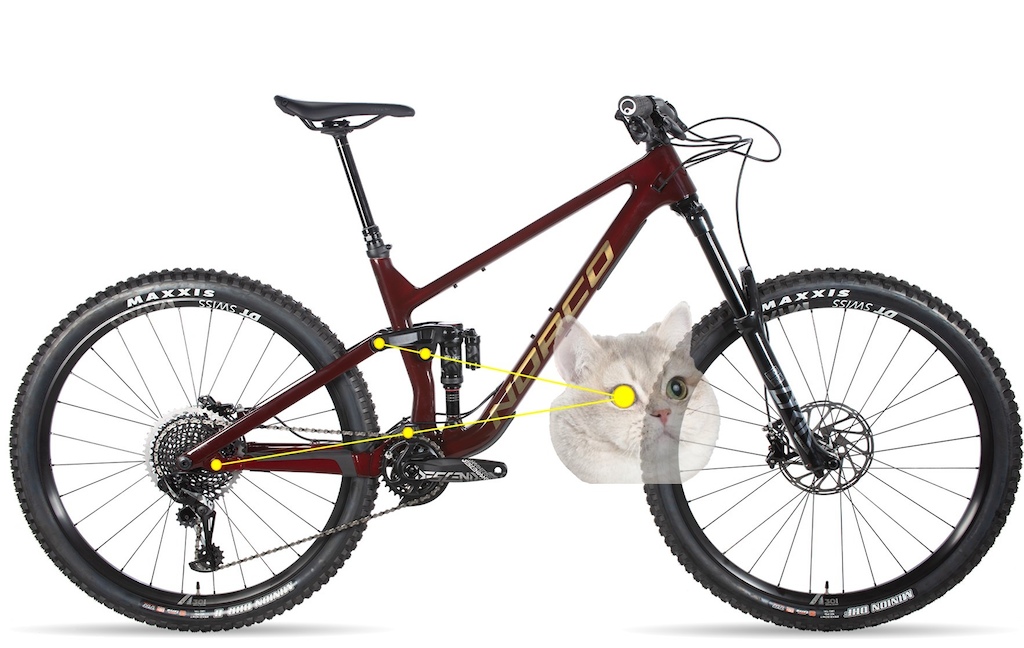
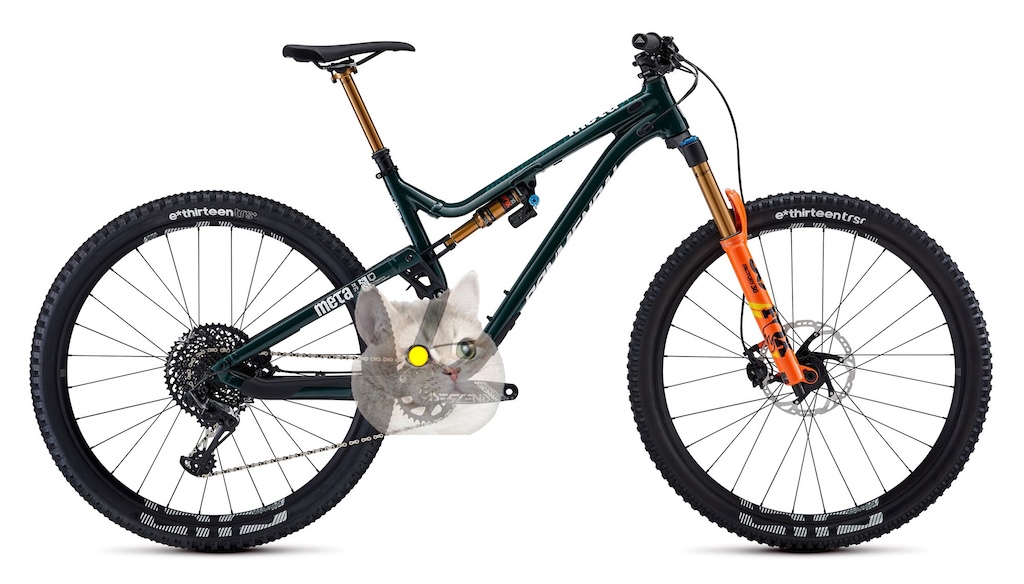
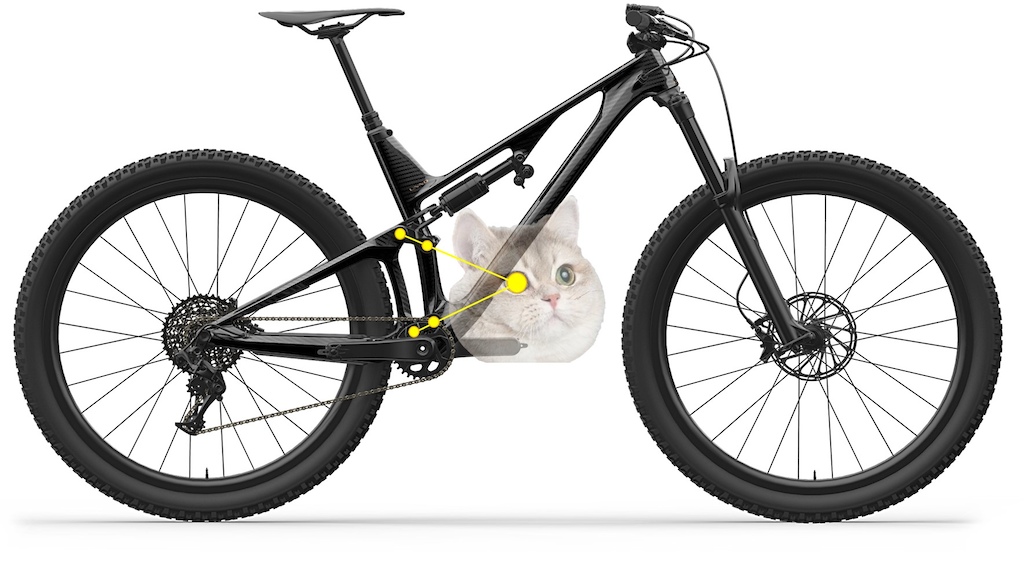

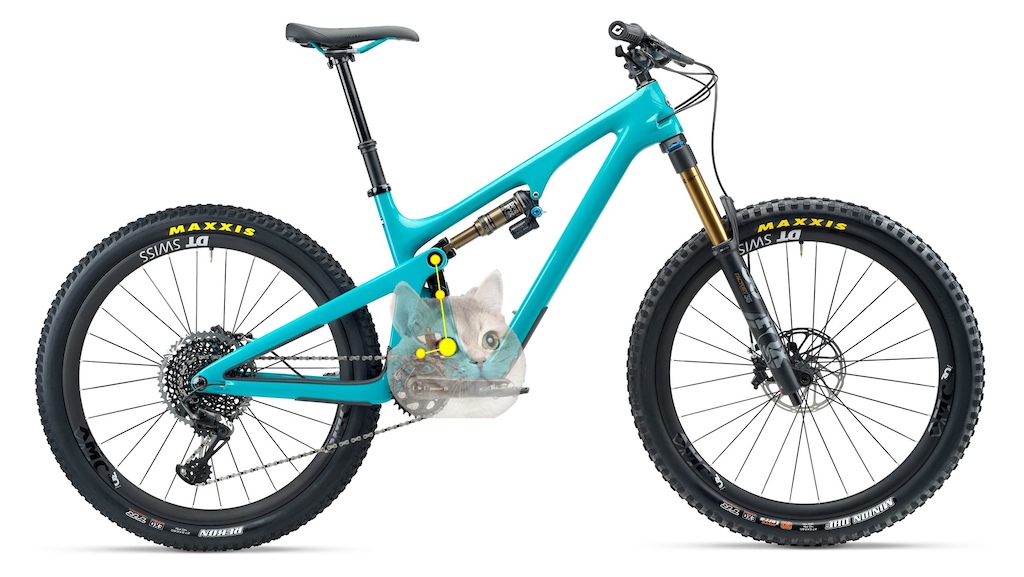
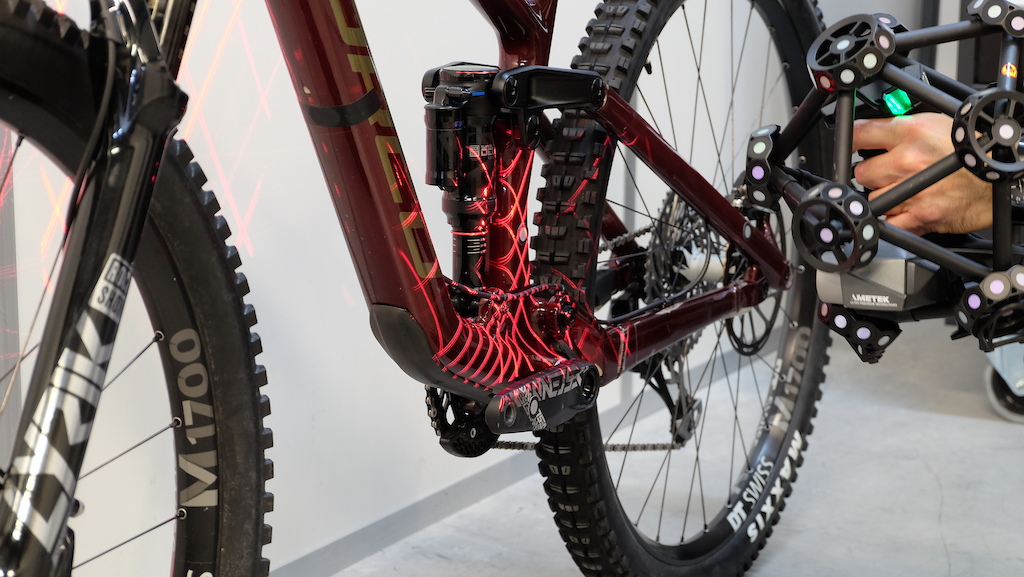

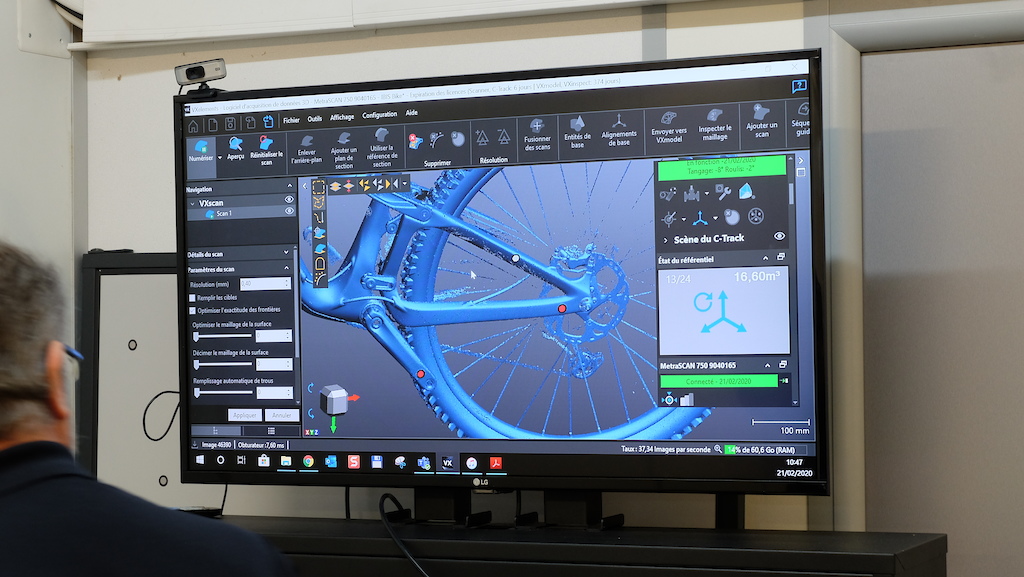


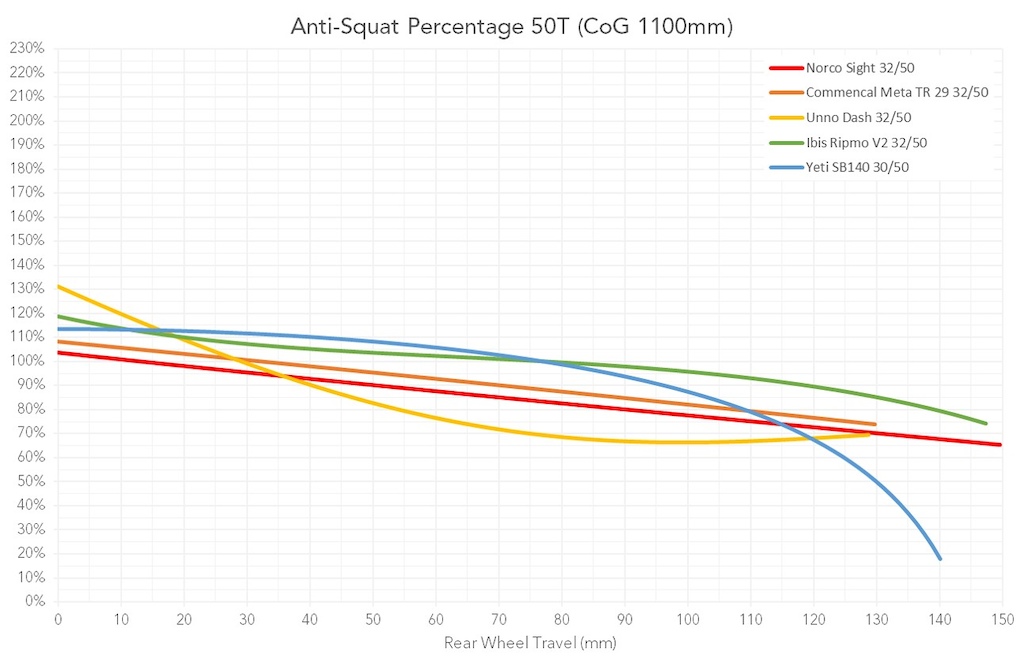

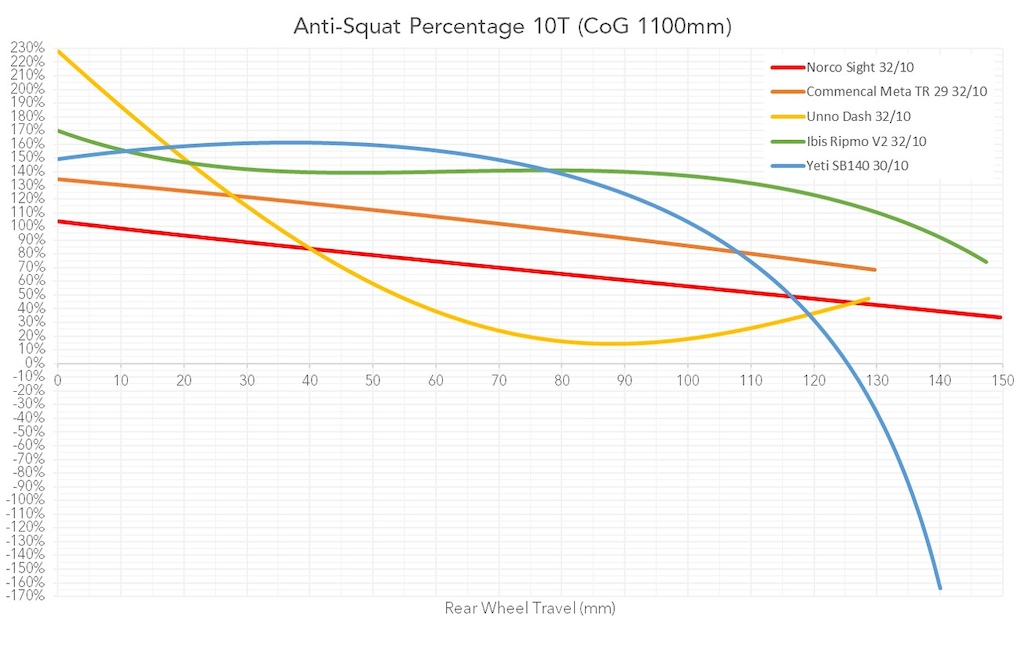


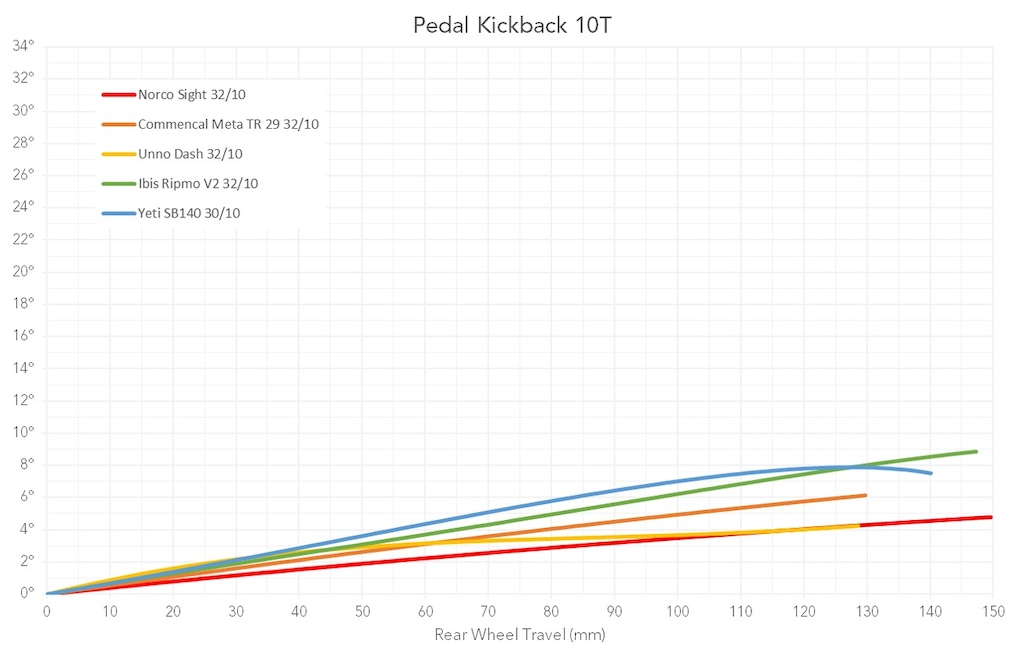


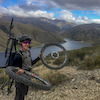
 Member since Apr 6, 2019
Member since Apr 6, 2019
1. the Norco must need the shock pressurized to 1,000 psi
2. the Yeti SB140 will snap in half before you can bottom it out with an air shock
I’m content with that for tonight.
Since all these bikes are scalded cat boulders with a fire road switch...how do I look at these numbers and say: this boulder cat has 3rd degree burns while this pebble one was just a bit too long in the sun???
Heck, now that I've dropped a few bills on people's Buy/Sell "Brand New Take Off" stuff, my 2018 Process 153 feels phenomenal.
But honestly, it comes from my 25 years or riding mountain bikes (I've ridden every conceivable concept over the years and there have been some real turds) . We are at the point where everything is working well, except certain aftermarket component makers whose products are by and in large garbage. But we won't say who.
I realize Amazon is loaded with a gazillion knock off parts brands, but there are a few on the mainstream side that get speced on high end & mid-grade bikes because of the name of their brand, not the quality they made their name on.
How many views of this article? I remember a while back Pinkbike saying 800,000 people visit the site. That's a sizable amount of people who are having some trouble clearly seeing the colors
most rear ward axle path. "gets out of the way of rocks"
high antisquat until late in travel firm antisquat when pedalling until it gets smashed
and good bottom out resistance on said smashing.
Too bad I hate Baby Blue
A day does not go by without thinking where I could find a brand new team edition Sanction and how I should modify it to make it work withe current perceived shortcomings. Because, after you put off-set headset, off-set bushings, 180mm fork and a dogbone on bearings, you'll still have the high seat tube and low-ish seat angle. I should know, I modified two(until now) in the same way.
The problem is, I have yet to find a suspension system that can make a 180mm bike pedal that good and, at the same time(and with the asisstance of an X2), to devour square hits like they simply do not exist. That's what a a high pivot+a rearward axle path+a floating bb will do for you kids. And, of course, it had effin' wings!
I did, it was too short. I would have liked to borrow that bike..like for a 2 years :sad: . I was almost with the money on the table for a frame(even though I did not liked their grey color), then I decided to take a blue comp and upgrade from there. Then I remember that I do not want to support Spez with these kind of amounts(4000 Euros for a frame, 3300 with a discount or 4200 for the comp version); last year I decided not to spend more than 4000 Euros for a bike(whatever the category, gravel, xc, trail, enduro, etc)...so, unless they get out on the market an aluminium version, I will not pay those amounts for a bike, even though I could and I really want the bike. It is like, I want the perfect unicorn: cheap, though, reliable, high-performance(capable). By the looks of it, I might still have to wait for a while.
Next time you're pedaling at 80%+ sag, make a video of it so we can all see how effective the antisquat value is at that point. Also, the rearward axle path on the 140 (which is mostly due to the reduced BB drop of the 27.5" frame) only increases chain growth, pedal kickback, and negatively affects rebound damping. The mass that moves rearward during an impact also has to return forward at some point, which will result in some strange feedback/damping challenges on successive hits. Dan has mentioned the drawbacks of excessive rearward axle movement in several articles.
Love this stuff. I’m getting old.
Shit I will never be able to choose another bike if I need to start doing this analysis. Add to that the over bike or under bike options from this selection starting point.. It is stressing me out.... what if I buy a bike with the wrong graph for my trails. What if I change where I ride and the graphs that used to work no longer work for my riding style. My excel spreadsheet is going to get much bigger where will I add all the new columns and rows... How will I weight these new variables. Oh the insanity, please stop it PB. Good thing I have lots of spare time due to the covid shutdown.
Where is Waki when we need him to be the voice of ....sanity? ...reason?....nevermind...
To be honest, I was super interested to know whether or not it was worth the price tag and something special was going on.
I can't help noticing though that the assembly is kind of strange...I mean, Sight is more towards the enduro side(maybe Optic would have been a better choice), Commencal has a new Meta TR now(which is actually burried deep into #enduro style bike type), Unno is relevant just for those 4 ppl who brought one, Ripmo V2 is in the same all-mountany-enduro-ish category as the Sight and, while the SB140 is still in production...I do think that maybe the SB130 would have been more appropriate.
Not really sure of is just me but, I was under the impression that trail category ends with 150mm forks(with usually, less travel in the back, as a 150-150 mm bike isn't really a trail bike)
Anyway, cheers and keep continuing with these awesome articles!
The issue here isn't that the author doesn't know what shock a bike is designed around (the UNNO comes with an Ohlins TTX Air), its that he doesn't any data on those shocks. Until that's part of the analysis, all the 3D scanning and kinematic analysis is just window dressing on the same vague opinions that have always belied bike reviews.
Shocks are designed and tuned around frames, not the other way around. The kinematic characteristics and geometry of a frame are what give the bike it's true identity. Dan focuses on the hard points of a bike that cannot be tuned or altered like shock, fork, tires, wheels, brakes, etc. can be.
Many frames come with multiple shock options from different manufacturers. Also, with springs and dampers, there is a wide range of adjustability. We exhaustively tune springs with pressure changes, volume spacers, coil spring rates, progressive coils, Sprindex, etc. Dampers are factory tuned to suit the leverage curve of the frame linkage (which dictates how the energy of rear wheel impact influences the damper shaft throughout the travel), then fine-tuned by the rider using external and/or internal adjustments. These all change the force profile the rear wheel sees along with the weight/speed of the rider. It would be futile to try to analyse all possible settings of all riders and all shocks one could run on a given frame.
One thing that might be a useful especially with the widely varied amounts of travel is to plot as a % of rear wheel travel instead of mm of rear wheel travel. I think this would make it easier to compare between bikes and give a better indication of why a bike has a particular suggested sag.
There is one change that I would make to your assumptions, though. I think fork travel needs to be accounted for in the kinematic graphs. If the fork travel was always the same as the rear wheel travel, then it wouldn't be a problem, but bike manufacturers optimize their geometry around the axle to crown of the fork they spec the bike with, and bikes with different travel in the front relative to the rear are going to behave differently.
For example, the Unno Dash is spec'd with 130 mm of rear travel and a 130 mm fork. With a 65.5* head angle, that means the vertical travel of the front wheel is 118 mm. On the other end, the Yeti SB140 is spec'd with 140 mm of rear travel and a 160 mm fork. With a 65* head angle, the vertical travel of the front wheel is 145 mm.
A 130 rear, 118 front bike will be pitched slightly backward at bottom out compared to extension, and a 140 rear, 145 front bike will pitch slightly forward at bottom out compared to extension. This will affect the anti squat and anti rise numbers differently for these two bikes, and should be taken into account when calculating the kinematics.
I know it adds complication, but along the same lines as using the spec'd chaining, it better represents the bike as it was intended by the manufacturer. In my opinion, this allows for a more accurate comparison between bikes.
Rear axle path, progressivity, anti squat, these are terms that maybe 5% of riders are really compelled by. Tons and tons of riders buy a bike because they like it, and while they will ride a different bike and know that there are differences between the two, they aren’t going to rattle off why the different linkage changes the kinematics of the suspension platform blah blah blah.
Bikes are so freaking good now. Not one of the bikes covered in the article is a loser. You won’t be poorly served on any of them, so whatever you like the look of or get a good deal on might just be the selling point.
A $2000 bike today spanks nearly anything on the market from 10 years ago.
Is that a thing? I've never heard that, ever. Or course, more travel can _eventually_ bring more kickback, but I don't think anyone has ever tried to say that longer overall travel means more kickback at a given travel...
I have a hard time with the definition y'all apply: anticipated degrees of reverse pedal rotation when suspension extends from X mm compressed to 0 mm (fully extended) resulting from forces generated as chain length extends from L mm (@X mm suspension compression) to some longer length L' (@0 mm suspension compression).
I'm a Clydesdale.
I ride a Ripmo v1.
When I stand up and mash on the pedals, especially up a slight hill, I feel a strange sensation. It feels like the bike has some kind of turbo boost acceleration or assistance that seems to increase my forward speed more than what it should be from just my applied power. It does not happen when seated. Only when standing and mashing. The more I bob up and down with my weight while actively pedaling, at just right frequency and cadence, the more powerful this force becomes. I have to go at or above a certain speed to feel it, almost like when a boat hydroplanes up and out of the water.
My question... Could the force causing pedal kickback be the same force that seems to increase the overall speed of the bike in this situation?
I will argue that it is.
The chain length is at its minimum length (L) at X mm suspension compression and grows to some longer length (L') and the suspension extends back towards 0mm.
L' - L = arc length of backwards pedal motion (kickback) = arc length of cassette FORWARD motion (kickforward?)
In any compression/extension cycle, there can be pedal kickback OR cassette kickforward. Since I am a Clydesdale, the dynamic force of me slamming down on my pedals surely overpowers any force with which the pedals can push back up against me. Therefore the all of the pedal kickback energy goes into cassette kickforward energy, which rotates the cassette forward, adding speed to my forward motion. The effect would be more pronounced in smaller cogs (higher speeds) because L-L' would be a larger % rotation due to smaller circumference of smaller cogs (think 2t of chain growth on 10t vs 50t cogs).
What do y'all think about this?
That's a weird statement... "moderately high" means a single degree more than the lowest? And according to those graphs it certainly didn't drop to "the lowest", it just matched the Sight...
Is this considering a zero-degree freehub engagement, or what?
What about the actual leverage of the brake on the suspension?
Your graphs and equations account for the load transfer, but what about the forces trying to rotate which ever suspension member the brake is attached to? You can see this easily on a single pivot with low/no pressure in the shock by suspending the bike off the ground, cranking the wheel, and hitting the brake. There is no load transfer, because the whole bike is not changing velocity, but the suspension will compress just from the leverage.
I mean, it's the whole idea behind ABP & SplitPivot, and it's also a good part of horst-link systems. This should be taken into account, because it's drastically change the actual anti-rise for single-pivots especially, but possibly also for short-links.
And how about the drag on a braking wheel pulling backwards and tending to pull the suspension to the rear-most point of the axle path? There is way more to anti-rise than just where the pivots are in relation to the front wheel.
Braking is one place that suspension design differences are harder to mitigate through shock tuning. For example, low anti-squat can be supplanted with more low-speed compression without much sacrifice. But a single pivot will always feel different to a well designed four-bar under heavy breaking. Maybe some mid- to high-speed compression can help a bit, but you then sacrifice traction at average- to high-speeds.
Earlier than what?
=(^_^)=